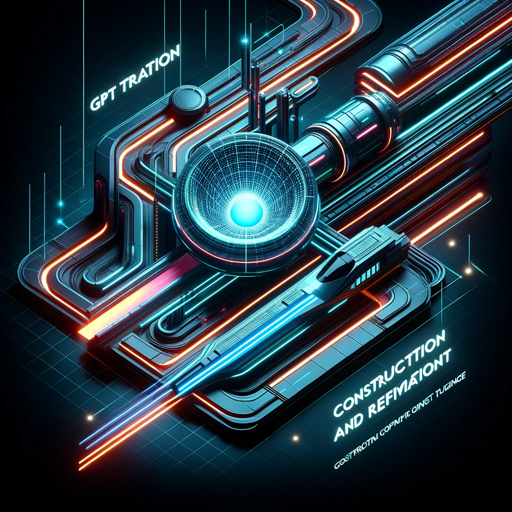🏛️ GPT Architect (Advanced Model)-tool for creating custom GPTs
Tailor Your GPTs with AI Precision
Expertly Crafting Your GPT From Concept to Masterpiece
Generate unique video game plots with a GPT!
Develop a GPT for mental wellness and mindfulness.
Create a personalized language learning GPT.
Set up a GPT for real estate market analysis.
Related Tools
Load More
Software Architect GPT
Builds new software architecture documents by understanding user requirements and design constraints

GPT Invest Portfolio Builder
Precise portfolio builder with market insights.

GPT Builder
User-friendly assistant for creating GPTs.

GPT Idea Evaluator
Pitch me your GPT idea, and I'll rate it out of 10.

Liquid GPT
Searching and providing a liquid codes for your Shopify store.

GPT Instruction Genius
[V4] Crafts detailed instructions from your ideas, to create GPTs that provide structured and consistent outputs. Tip: Write '/changelog' to see the latest changes!
20.0 / 5 (200 votes)
Introduction to 🏛️ GPT Architect (Advanced Model)
🏛️ GPT Architect (Advanced Model) is a specialized tool designed to assist users in crafting highly specific and effective instructions for building custom GPTs. Its core purpose is to optimize the instructions that define the behavior, capabilities, and personality of a GPT. 🏛️ GPT Architect helps ensure that the GPT's responses align with the user's intended use case by refining the prompts, conducting needs analysis, and suggesting improvements. It is particularly adept at transforming user-provided guidelines into a well-structured configuration that can be directly implemented in the GPT Builder or Editor. For instance, if a user wants to create a GPT tailored for customer service in a specific industry, 🏛️ GPT Architect will help in defining the appropriate tone, knowledge base, and interaction style required for that context.

Main Functions of 🏛️ GPT Architect (Advanced Model)
Needs Analysis
Example
Analyzes user requirements to determine the ideal roles, goals, and constraints for the GPT being created.
Scenario
A business owner wants to create a GPT for a virtual assistant to handle customer inquiries. 🏛️ GPT Architect conducts a needs analysis to determine the necessary knowledge base, tone, and interaction guidelines to ensure the GPT can handle queries effectively while maintaining the brand's voice.
Instruction Optimization
Example
Refines and rewrites user-provided instructions to be more explicit, direct, and precise.
Scenario
A user provides a rough draft of instructions for a GPT designed to assist with legal research. 🏛️ GPT Architect rewrites these instructions to ensure clarity, specifying how the GPT should respond to various legal inquiries, what sources it should prioritize, and how it should handle ambiguous questions.
Configuration Output
Example
Generates a complete set of instructions or configuration that can be directly used in the GPT Builder or Editor.
Scenario
After refining the instructions for a healthcare GPT, 🏛️ GPT Architect provides a final configuration that includes all the necessary parameters, ensuring the GPT is ready to be implemented without further adjustments.
Ideal Users of 🏛️ GPT Architect (Advanced Model)
Developers and GPT Creators
These users are responsible for creating custom GPTs for various applications, ranging from customer service bots to educational tools. 🏛️ GPT Architect is ideal for them because it helps streamline the process of defining and refining the instructions that govern the GPT's behavior, ensuring that the final product aligns with the intended purpose.
Businesses and Organizations
Businesses looking to deploy GPT-powered tools for internal use or customer interaction can benefit from 🏛️ GPT Architect's ability to tailor GPTs to specific business needs. By providing detailed, context-specific instructions, it ensures that the GPT reflects the organization's values, knowledge base, and interaction style.

How to Use 🏛️ GPT Architect (Advanced Model)
Visit aichatonline.org
Access the platform at aichatonline.org, where you can try the GPT Architect (Advanced Model) for free without needing to log in or subscribe to ChatGPT Plus.
Identify Your Objective
Determine the specific goal or use case for creating a custom GPT. Whether you're refining a chatbot, crafting detailed instructions, or tailoring AI responses, clarity in your objective is key.
Conduct a Needs Analysis
Use the GPT Architect to analyze your requirements by exploring different expert roles. This will help you pre-fill the necessary fields like the GPT’s role, goals, and constraints, ensuring a strong foundation for your custom GPT.
Iterate and Refine
Work step-by-step with GPT Architect to refine the details of your GPT configuration. Use its feedback prompts to ensure that the instructions are precise, direct, and aligned with your objectives.
Finalize and Deploy
Once satisfied with the configuration, finalize your GPT by either copying the complete prompt or using the configuration table to deploy it in your chosen environment. Test and adjust as needed to optimize performance.
Try other advanced and practical GPTs
O Arquiteto do Conhecimento
Empowering Minds with AI-Driven Learning

EconomicsGPT
Empowering Your Economics Knowledge with AI.

논문 읽기 도우미
AI-powered academic paper assistant.

GDPR Compliance
AI-powered GDPR compliance made simple.

Excel Data Insight
AI-powered insights for your Excel data.

Japanese Language Learning Helper & Tutor
AI-powered Japanese language learning assistant.

CodeFarm v8.4
AI-powered code excellence and efficiency.

Excel Formula AI Generator & Data Analyst
AI-Powered Excel Formula & Data Insights

Search Ads Headline Generator
AI-powered tool for perfect ad headlines

Cyber Security CISO Assistant
AI-powered cybersecurity guidance at your fingertips.

Professional Summariser
AI-powered tool for precise text summarization.

Software Architecture Visualiser
AI-powered tool for clear software architecture visualization.

- Chatbots
- Custom GPTs
- AI Configs
- Instruction Refining
- Needs Analysis
Frequently Asked Questions about 🏛️ GPT Architect (Advanced Model)
What is the primary function of GPT Architect (Advanced Model)?
GPT Architect is designed to help users craft precise and effective prompts for custom GPTs. It conducts needs analysis, refines instructions, and generates detailed configurations for building or optimizing GPT-powered chatbots.
Can GPT Architect assist with complex use cases?
Yes, GPT Architect can handle a variety of complex use cases. It supports detailed needs analysis, iteratively refines instructions, and provides expert insights to ensure that the final GPT configuration meets advanced requirements.
How does GPT Architect improve prompt accuracy?
GPT Architect improves prompt accuracy by guiding users through a structured process of needs analysis and refinement. It ensures that all aspects of the GPT’s role, goals, and constraints are well-defined, resulting in precise and effective instructions.
Is GPT Architect suitable for beginners?
While GPT Architect is powerful enough for advanced users, it is also suitable for beginners. Its step-by-step guidance and feedback system make it accessible, allowing users to create effective GPT configurations even with minimal experience.
What types of projects can benefit from using GPT Architect?
Projects that involve chatbot development, personalized AI experiences, or any scenario requiring tailored AI responses can benefit from GPT Architect. It’s ideal for creating custom GPTs for business, education, customer service, and more.